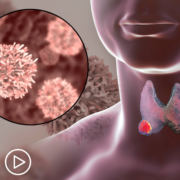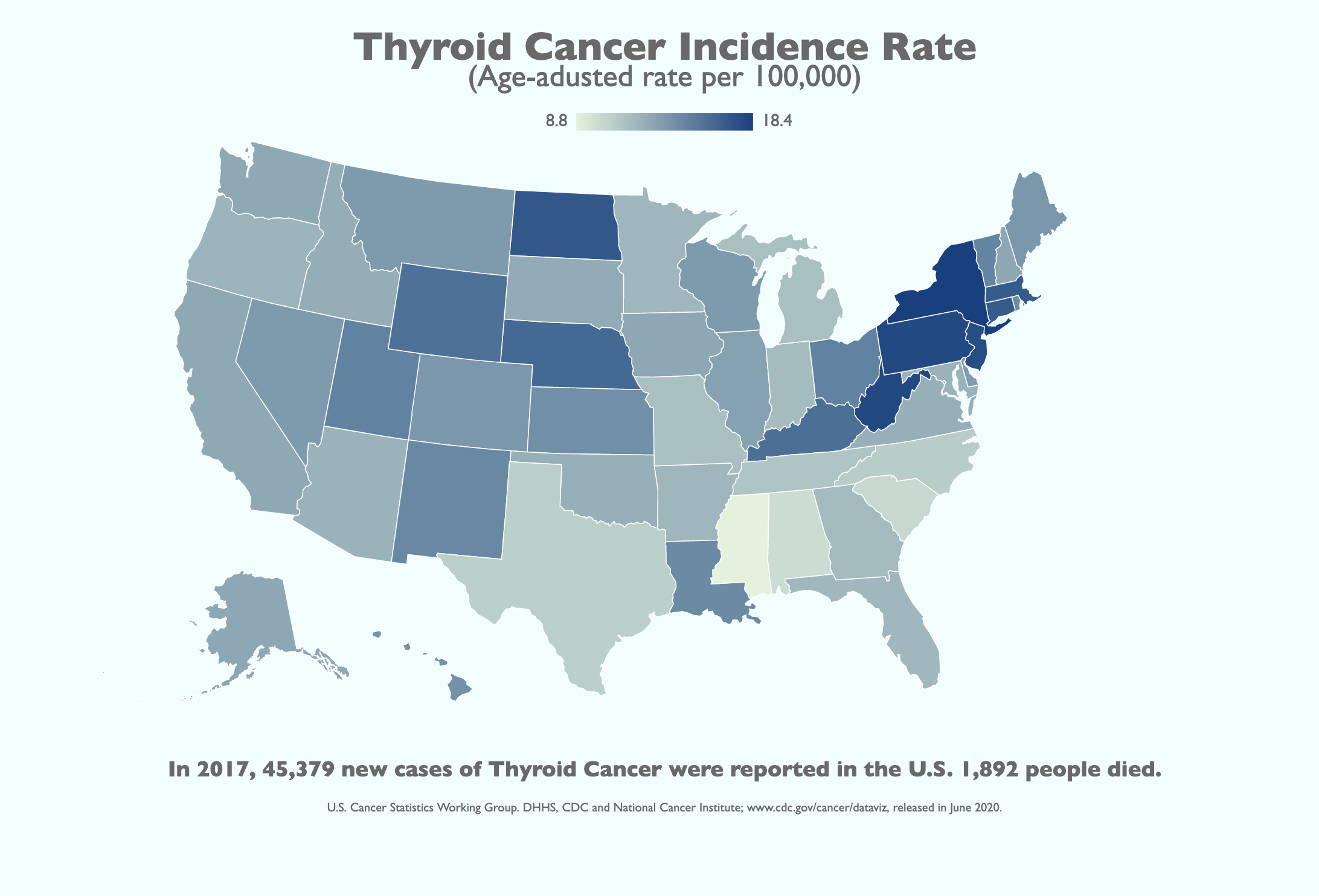Thyroid cancer may be diagnosed after a person goes to a doctor because of symptoms, or it might be found during a routine physical exam or other tests. If there is a reason to suspect you might have thyroid cancer, your doctor will use one or more tests to confirm the diagnosis. If cancer is found, other tests might be done to find out more about the cancer.
Medical history and physical exam
If you have any signs or symptoms that suggest you might have thyroid cancer, your health care professional will want to know your complete medical history. You will be asked questions about your possible risk factors, symptoms, and any other health problems or concerns. If someone in your family has had thyroid cancer (especially medullary thyroid cancer) or tumors called pheochromocytomas, it is important to tell your doctor, as you might be at high risk for this disease.
Your doctor will examine you to get more information about possible signs of thyroid cancer and other health problems. During the exam, the doctor will pay special attention to the size and firmness of your thyroid and any enlarged lymph nodes in your neck.
Imaging tests
Imaging tests may be done for a number of reasons:
- To help find suspicious areas that might be cancer
- To learn how far cancer may have spread
- To help determine if treatment is working
People who have or may have thyroid cancer will get one or more of these tests.
Ultrasound
Ultrasound uses sound waves to create images of parts of your body. You are not exposed to radiation during this test.
This test can help determine if a thyroid nodule is solid or filled with fluid. (Solid nodules are more likely to be cancerous.) It can also be used to check the number and size of thyroid nodules as well as help determine if any nearby lymph nodes are enlarged because the thyroid cancer has spread.
For thyroid nodules that are too small to feel, this test can be used to guide a biopsy needle into the nodule to get a sample. Even when a nodule is large enough to feel, most doctors prefer to use ultrasound to guide the needle.
Radioiodine scan
Radioiodine scans can be used to help determine if someone with a lump in the neck might have thyroid cancer. They are also often used in people who have already been diagnosed with differentiated (papillary, follicular, or Hürthle cell) thyroid cancer to help show if it has spread. Because medullary thyroid cancer cells do not absorb iodine, radioiodine scans are not used for this cancer.
For this test, a small amount of radioactive iodine (called I-131) is swallowed (usually as a pill) or injected into a vein. Over time, the iodine is absorbed by the thyroid gland (or thyroid cells anywhere in the body). A special camera is used several hours later to see where the radioactivity is.
For a thyroid scan, the camera is placed in front of your neck to measure the amount of radiation in the gland. Abnormal areas of the thyroid that have less radioactivity than the surrounding tissue are called cold nodules, and areas that take up more radiation are called hot nodules. Hot nodules usually are not cancerous, but cold nodules can be benign or cancerous. Because both benign and cancerous nodules can appear cold, this test by itself can’t diagnose thyroid cancer.
After surgery for thyroid cancer, whole-body radioiodine scans are useful to look for possible spread throughout the body. These scans become even more sensitive if the entire thyroid gland has been removed by surgery because more of the radioactive iodine is picked up by any remaining thyroid cancer cells.
Radioiodine scans work best if patients have high blood levels of thyroid-stimulating hormone (TSH, or thyrotropin). For people whose thyroid has been removed, TSH levels can be increased by stopping thyroid hormone pills for a few weeks before the test. This leads to low thyroid hormone levels (hypothyroidism) and causes the pituitary gland to release more TSH, which in turn stimulates any thyroid cancer cells to take up the radioactive iodine. A downside of this is that it can cause the symptoms of hypothyroidism, including tiredness, depression, weight gain, sleepiness, constipation, muscle aches, and reduced concentration. One way to raise TSH levels without withholding thyroid hormone is to give an injectable form of thyrotropin (Thyrogen) before the scan.
Because any iodine already in the body can affect this test, people are usually told to avoid foods or medicines that contain iodine for a few days before the scan.
Radioactive iodine can also be used to treat differentiated thyroid cancer, but it is given in much higher doses. This type of treatment is described in Radioactive iodine (radioiodine) therapy.
Chest x-ray
If you have been diagnosed with thyroid cancer (especially follicular thyroid cancer), a plain x-ray of your chest may be done to see if cancer has spread to your lungs.
Computed tomography (CT) scan
The CT scan is an x-ray test that makes detailed cross-sectional images of your body. It can help determine the location and size of thyroid cancers and whether they have spread to nearby areas, although ultrasound is usually the test of choice. A CT scan can also be used to look for spread into distant organs such as the lungs.
One problem using CT scans is that the CT contrast dye contains iodine, which interferes with radioiodine scans. For this reason, many doctors prefer MRI scans for differentiated thyroid cancer.
Magnetic resonance imaging (MRI) scan
MRI scans use magnets instead of radiation to create detailed cross-sectional images of your body. MRI can be used to look for cancer in the thyroid, or cancer that has spread to nearby or distant parts of the body. But ultrasound is usually the first choice for looking at the thyroid. MRI can provide very detailed images of soft tissues such as the thyroid gland. MRI scans are also very helpful in looking at the brain and spinal cord.
Positron emission tomography (PET) scan
A PET scan can be very useful if your thyroid cancer is one that doesn’t take up radioactive iodine. In this situation, the PET scan may be able to tell whether the cancer has spread.
Biopsy
The actual diagnosis of thyroid cancer is made with a biopsy, in which cells from the suspicious area are removed and looked at in the lab.
If your doctor thinks a biopsy is needed, the simplest way to find out if a thyroid lump or nodule is cancerous is with a fine needle aspiration (FNA) of the thyroid nodule. This type of biopsy can sometimes be done in your doctor’s office or clinic.
Before the biopsy, local anesthesia (numbing medicine) may be injected into the skin over the nodule, but in most cases an anesthetic is not needed. Your doctor will place a thin, hollow needle directly into the nodule to aspirate (take out) some cells and a few drops of fluid into a syringe. The doctor usually repeats this 2 or 3 more times, taking samples from several areas of the nodule. The biopsy samples are then sent to a lab, where they are looked at to see if the cells look cancerous or benign.
Bleeding at the biopsy site is very rare except in people with bleeding disorders. Be sure to tell your doctor if you have problems with bleeding or are taking medicines that could affect bleeding, such as aspirin or blood thinners.
This test is generally done on all thyroid nodules that are big enough to be felt. This means that they are larger than about 1 centimeter (about 1/2 inch) across. Doctors often use ultrasound to see the thyroid during the biopsy, which helps make sure they are getting samples from the right areas. This is especially helpful for smaller nodules. FNA biopsies can also be used to get samples of swollen lymph nodes in the neck to see if they contain cancer.
Sometimes an FNA biopsy will need to be repeated because the samples didn’t contain enough cells. Most FNA biopsies will show that the thyroid nodule is benign. Rarely, the biopsy may come back as benign even though cancer is present. Cancer is clearly diagnosed in only about 1 of every 20 FNA biopsies.
Sometimes the test results first come back as “suspicious” or “of undetermined significance” if FNA findings don’t show for sure if the nodule is either benign or malignant. If this happens, the doctor may order lab tests on the sample (see below).
If the diagnosis is not clear after an FNA biopsy, you might need a more involved biopsy to get a better sample, particularly if the doctor has reason to think the nodule may be cancer. This might include a core biopsy using a larger needle, a surgical “open” biopsy to remove the nodule, or a lobectomy (removal of half of the thyroid gland). Surgical biopsies and lobectomies are done in an operating room while you are under general anesthesia (in a deep sleep). A lobectomy can also be the main treatment for some early cancers, although for many cancers the rest of the thyroid will need to be removed as well (during an operation called a completion thyroidectomy).
Lab tests of biopsy (or other) samples
In some cases, doctors might use molecular tests to look for specific gene changes in the cancer cells. This might be done for different reasons:
- If FNA biopsy results aren’t clear, the doctor might order lab tests on the samples to see if there are changes in the BRAF or RET/PTC genes. Finding one of these changes makes thyroid cancer much more likely.
- For some types of thyroid cancer, molecular tests might be done to see if the cancer cells have changes in certain genes (such as the BRAF, RET/PTC, or NTRK genes), which could mean that certain targeted drugs might be helpful in treating the cancer.
These tests can be done on tissue taken during a biopsy or surgery for thyroid cancer. If the biopsy sample is too small and all the molecular tests can’t be done, the testing may also be done on blood that is taken from a vein, just like a regular blood draw.
Blood tests
Blood tests are not used to find thyroid cancer. But they can help show if your thyroid is working normally, which may help the doctor decide what other tests may be needed. They can also be used to monitor certain cancers.
Thyroid-stimulating hormone (TSH)
Tests of blood levels of thyroid-stimulating hormone (TSH or thyrotropin) may be used to check the overall activity of your thyroid gland. Levels of TSH, which is made by the pituitary gland, may be high if the thyroid is not making enough hormones. This information can be used to help choose which imaging tests (such as ultrasound or radioiodine scans) to use to look at a thyroid nodule. The TSH level is usually normal in thyroid cancer.
T3 and T4 (thyroid hormones)
These are the main hormones made by the thyroid gland. Levels of these hormones may also be measured to get a sense of thyroid gland function. The T3 and T4 levels are usually normal in thyroid cancer.
Thyroglobulin
Thyroglobulin is a protein made by the thyroid gland. Measuring the thyroglobulin level in the blood can’t be used to diagnose thyroid cancer, but it can be helpful after treatment. A common way to treat thyroid cancer is to remove most of the thyroid by surgery and then use radioactive iodine to destroy any remaining thyroid cells. These treatments should lead to a very low level of thyroglobulin in the blood within several weeks. If it is not low, this might mean that there are still thyroid cancer cells in the body. If the level rises again after being low, it is a sign that the cancer could be coming back.
Calcitonin
Calcitonin is a hormone that helps control how the body uses calcium. It is made by C cells in the thyroid, the cells that can develop into medullary thyroid cancer (MTC). If MTC is suspected or if you have a family history of the disease, blood tests of calcitonin levels can help look for MTC. This test is also used to look for the possible recurrence of MTC after treatment. Because calcitonin can affect blood calcium levels, these may be checked as well.
Carcinoembryonic antigen (CEA)
People with MTC often have high blood levels of a protein called carcinoembryonic antigen (CEA). Tests for CEA can help monitor this cancer.
Other blood tests
You might have other blood tests as well. For example, if you are scheduled for surgery, tests will be done to check your blood cell counts, to look for bleeding disorders, and to check your liver and kidney function.
Medullary thyroid carcinoma (MTC) can be caused by a genetic syndrome that also causes a tumor called pheochromocytoma. Pheochromocytomas can cause problems during surgery if the patient is under anesthesia (in a deep sleep). This is why patients with MTC who will have surgery are often tested to see if they have a pheochromocytoma as well. This can mean blood tests for epinephrine (adrenaline) and a related hormone called norepinephrine, and/or urine tests for their breakdown products (called metanephrines).
Vocal cord exam (laryngoscopy)
Thyroid tumors can sometimes affect the vocal cords. If you are going to have surgery to treat thyroid cancer, a procedure called a laryngoscopy will probably be done first to see if the vocal cords are moving normally. For this exam, the doctor looks down the throat at the larynx (voice box) with special mirrors or with a laryngoscope, a thin tube with a light and a lens on the end for viewing.














:max_bytes(150000):strip_icc():format(webp)/illo_Doctor-discussion-guide-01-5c3e5b20c9e77c00015d2ba5.png)


